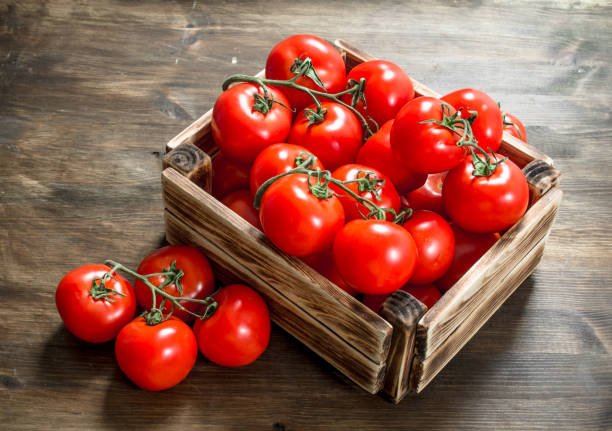Tomatoes
What Are Tomatoes?
A staple in numerous cuisines, the tomato is arguably one of the most widely used produce items in the United States, and not just because of pizza. Americans also love to grow their own: Tomatoes are the most commonly planted home crop in the country, according to the University of Illinois Urbana-Champaign.
Tomatoes are often referred to as vegetables, but they are technically the fruit of a flowering plant called Solanum lycopersicum, according to Britannica. They belong to a family of fruits and vegetables known as nightshades, which includes potatoes and eggplants. While nightshades have gotten a bad reputation in recent years (Gisele Bündchen famously said she avoided them) because of possible issues with food sensitivities or allergies, the Cleveland Clinic explains that the heart of the issue is their alkaloid content, which is typically only harmful in large doses. The claim that nightshades create disease-causing inflammation has not been proved.
Tomatoes are thought to be indigenous to South America, but gained worldwide popularity after Spanish explorers introduced the fruit to Europe in the 16th century. Since then, tomatoes have been associated with Latin American, Italian, and Mediterranean dishes, but their versatility has made them a significant part of numerous cuisines.


Types of Tomatoes
While most of the tomatoes you may come across at supermarkets are various shades of red, orange, or yellow, green and purple tomatoes also exist. These are less common, but you may be able to find them at specialty stores or at farmers’ markets. Here is a breakdown of some of the most common tomato varieties
- Beefsteak Nicknamed the “king of tomatoes,” this juicy variety is the most versatile, for use in cooking, salsa, sauces, and on top of sandwiches and burgers.
- Cocktail This sweeter variety works well in sauces, grilled, or added on top of pasta and meat dishes.
- Heirloom Coveted for their unique appearance and larger size, heirloom tomatoes work best when chopped up into salads and sandwiches, though they can also be roasted or grilled.
- Grape These small, thick, and crunchy tomatoes work great as snacks, and their texture holds up well when cooked.
- Cherry Another versatile variety, cherry tomatoes make great snacks, and they’re great on top of salads, in sauces, and on skewers.
- Roma Traditionally used in Italian dishes and known for their tangy flavor, these plum-shaped tomatoes make tasty additions to sauces, sandwiches, and salads.
Tomato Nutrition Facts
No matter what type of tomato you prefer, know that each fruit is low in calories, with a high nutrient content, including antioxidants.
“Tomatoes are rich in various antioxidants, including lycopene, which gives them their red color and offers several health benefits,” says Trista Best, MPH, RD, a consultant with Balance One Supplements based in Georgia. She also notes that tomatoes contain some vitamin C, potassium, vitamin A, and folate.
Per the USDA, one medium tomato contains:
- Calories: 22
- Protein: 1.08 grams (g)
- Fat: 0.2 g
- Carbohydrates: 4.78 g
- Fiber: 1.48 g
- Sugars: 3.24 g
- Calcium: 12.3 milligrams (mg)
- Iron: 0.3 mg
- Potassium: 292 mg
- Sodium: 6.15 mg
Potential Health Benefits of Tomatoes
Tomatoes, like other antioxidant-rich fruits and vegetables, can offer a variety of health benefits when incorporated into a balanced diet. Here are some of the key benefits that both experts and researchers have identified.
May Reduce Cancer Risk
Tomatoes’ potential anticancer effects are attributed to the powerful antioxidant lycopene. “It is known for its potential to reduce the risk of certain types of cancer, particularly prostate cancer,” says Best. According to the World Cancer Research Fund International, a study of men who consumed canned or cooked tomatoes five to six times per week were found to have a 28 percent lower risk of prostate cancer than men who ate no tomatoes. It’s important to note that the researchers found no effect on prostate cancer risk when they considered tomatoes in raw, juice, soup, or sauce form. It was found that cooking the tomatoes helped with lycopene absorption, particularly cooking them with olive oil. Also, per a 2022 review, lycopene has been widely studied for its ability to protect DNA in cells against the development of several other cancers, such as those of the colon, breast, and blood.
May Have Cardiovascular Benefits
Lycopene is also thought to be responsible for a number of cardiovascular benefits associated with tomatoes. Lycopene “can contribute to cardiovascular health by reducing the risk of heart disease and lowering blood pressure,” says Best. One review published in February 2022 in the International Journal of Molecular Sciences found a growing body of evidence showing lycopene’s benefits, particularly for people with atherosclerosis and hypertension.
Michigan State University notes that other components of tomatoes may be heart protective as well. These include potassium and B vitamins, which may help reduce cholesterol and blood pressure, and thus decrease the overall risk of heart attack and stroke. Potassium has other essential benefits besides its role in your heart health, including body fluid balance, nerve function, and healthy muscle contractions, according to the National Institutes of Health (NIH).
Can Help You Get Vitamin A
Carrots and sweet potatoes shouldn’t be your only sources of vitamin A. USDA data shows that tomatoes are an important source of beta-carotene, which Best says is “a precursor to vitamin A,” and is essential for vision, immune function, and cell growth, according to the NIH. What’s more, vitamin A from tomatoes can help protect your night vision and cut the risk of age-related macular degeneration.
May Protect Your Skin
“Additionally, lycopene may have protective effects on the skin, helping to prevent sun damage and improve skin texture,” says Best. A systematic review and meta-analysis published in January 2023 in Critical Reviews in Food Science and Nutrition found that dietary supplements of tomato and lycopene helped prevent light-induced photodamage to the skin. Best also notes that the vitamin C content of tomatoes supports collagen synthesis, which is important in helping your skin maintain its elasticity and hydration. Moreover, Michigan State University points out that the beta-carotene in tomatoes may help protect your skin from UV damage.
Can Tomatoes Help With Weight Loss?
While there’s no tomato-specific diet per se, the more fruits and vegetables in your diet, the easier it is to both lose and maintain your weight. As the Centers for Disease Control and Prevention (CDC) notes, produce like tomatoes create a calorie deficit while keeping you feeling full because of their naturally low calories but high nutrient content. Plus, tomatoes are rich in fiber and are more than 90 percent water, both of which aid satiety.
To create a calorie deficit, the CDC recommends swapping out high-calorie, high-fat items for tomatoes. For example, you can eat more sliced tomatoes with vegetables in place of pasta or rice, or add chopped tomatoes to omelets, wraps, and burritos instead of cheese.
The Keck School of Medicine at the University of Southern California says that tomatoes may help with appetite control because they contribute to leptin resistance. Leptin is a type of hormone that’s responsible for telling your brain that you’re full — when you’re leptin resistant, your brain erroneously tells you you’re hungry when you’re not. “In addition to increasing circulating leptin levels, tomatoes may help increase leptin sensitivity by reducing inflammation within the body, because inflammation is felt to be a primary cause of leptin resistance,” says Gillespie.
Still, Best cautions that not enough research has been done on this end. “More research is needed to fully understand the relationship between tomatoes, leptin resistance, and weight management,” she says.
How to Select and Store Tomatoes
Due to imports from other countries, you may be able to find tomatoes at grocery stores year-round. According to the USDA, local tomatoes are in season during the summer months.
Below are some important tips for selection and storage so you can get the most benefits and best taste out of your tomatoes.
Selection
No matter which tomatoes you choose, The Foundation for Fresh Produce recommends looking for those that have bright, shiny skins and are firm to the touch. The University of California in San Diego notes that a ripe tomato ought to have a sweet smell. As a rule of thumb, avoid tomatoes that smell sour or bitter, or have mushy, bruised skins.
Canned tomatoes are another option for having tomatoes year-round or if you’re in a hurry. Ideally, you should look for cans labeled reduced-sodium or salt-free.
Storage
Ripe tomatoes last about one week and are best kept at room temperature. If, however, you cut or cook a tomato and don’t use it all at once, you can refrigerate leftovers for up to two days. You can also place raw or cooked tomatoes in your freezer for up to two months.








